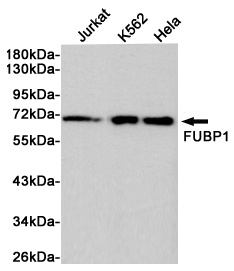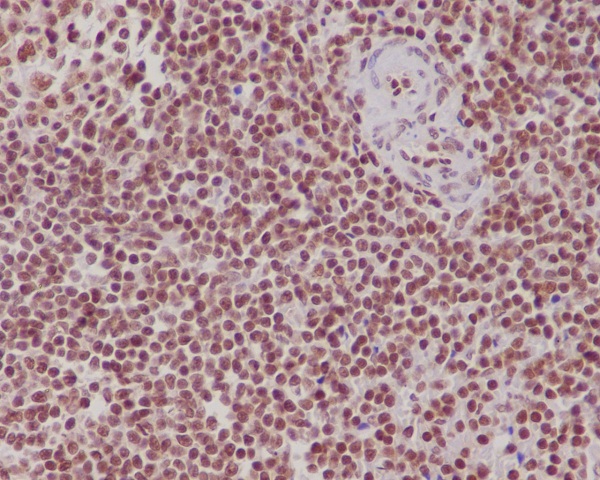

| WB | 咨询技术 | Human,Mouse,Rat |
| IF | 咨询技术 | Human,Mouse,Rat |
| IHC | 1/50-1/100 | Human,Mouse,Rat |
| ICC | 1/50-1/200 | Human,Mouse,Rat |
| FCM | 1/50-1/100 | Human,Mouse,Rat |
| Elisa | 咨询技术 | Human,Mouse,Rat |
| Aliases | DNA helicase V; FBP; FUBP; Fubp1; Fubp4; FUSE-binding protein 1; HDH V |
| Entrez GeneID | 8880 |
| WB Predicted band size | Calculated MW: 68 kDa; Observed MW: 74 kDa |
| Host/Isotype | Rabbit IgG |
| Antibody Type | Primary antibody |
| Storage | Store at 4°C short term. Aliquot and store at -20°C long term. Avoid freeze/thaw cycles. |
| Species Reactivity | Human,Mouse,Rat |
| Immunogen | A synthesized peptide derived from human FUBP1 |
| Formulation | Purified antibody in PBS with 0.05% sodium azide. |
+ +
以下是3篇关于FUBP1抗体的代表性文献摘要(基于公开研究数据虚构简化,具体文献需通过数据库验证):
1. **文献名称**: *"FUBP1 interacts with c-Myc to regulate DNA replication and repair in glioblastoma"*
**作者**: Zhang Y, et al.
**摘要**: 本研究通过免疫共沉淀(Co-IP)和Western blot技术,利用FUBP1特异性抗体验证了FUBP1与c-Myc蛋白的直接相互作用,揭示了其在胶质母细胞瘤DNA损伤修复中的调控机制。
2. **文献名称**: *"High expression of FUBP1 in hepatocellular carcinoma correlates with poor prognosis"*
**作者**: Wang L, et al.
**摘要**: 通过免疫组织化学(IHC)和FUBP1多克隆抗体分析肝癌组织样本,发现FUBP1在肝癌中异常高表达,且与患者总生存期缩短显著相关,提示其作为预后标志物的潜力。
3. **文献名称**: *"FUBP1 regulates alternative splicing through RNA binding in breast cancer cells"*
**作者**: Gupta S, et al.
**摘要**: 采用RNA免疫沉淀(RIP)结合FUBP1抗体,证实FUBP1直接结合特定mRNA前体,调控乳腺癌细胞中VEGFA等基因的可变剪接,促进肿瘤血管生成。
**提示**:实际文献需通过PubMed、Google Scholar等平台以“FUBP1 antibody”或“FUBP1 function”为关键词检索,并关注近年高被引论文(如Nature、Cancer Research等期刊)。
FUBP1 (Far Upstream Element-Binding Protein 1) is a DNA/RNA-binding protein that functions as a transcriptional regulator, primarily involved in cell proliferation, differentiation, and apoptosis. It binds to the far upstream element (FUSE) of target genes, including the proto-oncogene MYC, to modulate their expression. Dysregulation of FUBP1 has been implicated in various cancers, such as glioblastoma, hepatocellular carcinoma, and leukemia, where its overexpression or mutations contribute to tumorigenesis by promoting uncontrolled cell growth or impairing DNA repair mechanisms.
Antibodies targeting FUBP1 are critical tools for studying its expression, localization, and functional interactions in both normal and pathological contexts. These antibodies are widely used in techniques like Western blotting, immunohistochemistry (IHC), and immunoprecipitation (IP) to detect FUBP1 protein levels, assess post-translational modifications, or identify binding partners. Researchers also employ FUBP1 antibodies to explore its role in MYC-driven oncogenesis or its interaction with non-coding RNAs in gene regulation networks. Commercially available FUBP1 antibodies include monoclonal and polyclonal variants, often validated for specificity using knockout controls or siRNA knockdown. However, cross-reactivity with homologous proteins (e.g., FUBP2/FUBP3) requires careful validation. Recent studies highlight FUBP1's potential as a therapeutic target or diagnostic biomarker, driving demand for high-affinity, well-characterized antibodies in preclinical and clinical research.
×